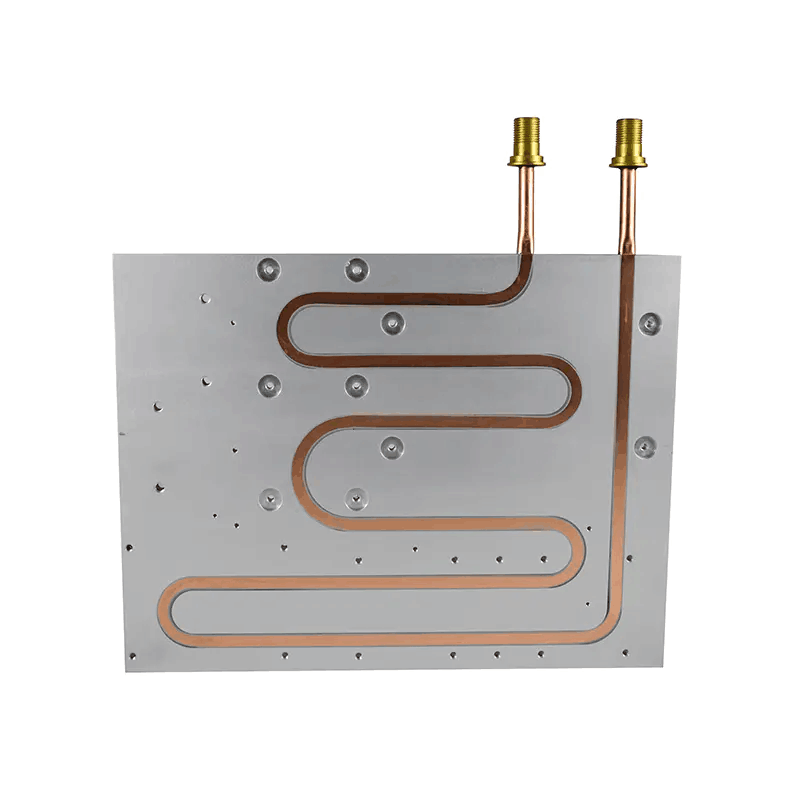The power battery heatsink is a crucial component of the power battery system, primarily functioning to dissipate heat. With the rapid development of electric vehicles, the use of power batteries is becoming increasingly widespread. The design and performance of the heatsink directly influence the stability, lifespan, and safety of the battery system.
As one of the core components in the power battery system, the heatsink dissipates heat generated inside the battery to the external environment using the working principle of a heat exchanger. Effective heat dissipation from the heatsink reduces the battery's temperature, improving the working efficiency and stability of the battery system.
In a power battery system, different types of batteries may produce varying amounts of heat. Therefore, the design of the heatsink needs to consider these differences as well as the characteristics of the battery. Each heatsink type has its own applicable scenarios and characteristics.
1. Types and Design Points of heatsinks
Based on the heat dissipation medium, heatsinks can be divided into two types: air-cooled heatsinks and liquid-cooled heatsinks.
**Air-Cooled heatsink**: The air-cooled heatsink achieves heat dissipation by using a large area of fins and increasing airflow with the help of a fan. Key design points include the shape, density, and material selection of the fins. The shape of the fins should have good aerodynamic characteristics to facilitate airflow and improve heat dissipation efficiency. Excessive fin density may increase airflow resistance, while too low a density will affect heat dissipation. The material chosen should have excellent heat dissipation properties, corrosion resistance, and strength.
**Liquid-Cooled heatsink**: The liquid-cooled heatsink primarily uses water or other coolants to absorb the battery's heat, which is then discharged through the heatsink. This type of heatsink can provide higher heat dissipation efficiency compared to air-cooled heatsinks but requires more complex piping and cooling systems. Key design points include the coolant flow method, heatsink material selection, and the design of the heat dissipation tubes.
2. Structure of the Power Battery heatsink
The power battery heatsink mainly comprises heat sinks, heat pipes, cooling fans, and coolant pipelines.
**Heat Sinks**: Heat sinks are the main part of the heatsink, typically made from aluminum alloys, copper, or aluminum-magnesium alloys. The design of the heat sinks needs to ensure excellent heat dissipation performance and low weight to achieve efficient thermal conduction and dissipation. Heat sinks often have a thin, sheet-like structure to increase the dissipation area and reduce airflow resistance.
**Heat Pipes**: Heat pipes connect the heat sinks and coolant pipelines, typically made from copper or aluminum for their good thermal conductivity. They transfer heat from the heat sinks to the coolant, achieving the dissipation effect. The design of heat pipes should consider the layout and length of the pipes to maximize heat transfer efficiency.
**Cooling Fans**: Cooling fans are key components of the heatsink, generating strong airflow to increase the surface air speed over the heat sinks, thus enhancing heat dissipation. Cooling fans usually use DC motors, providing good airflow and noise control performance.
**Coolant Pipelines**: Coolant pipelines, including inlet and outlet pipes, are used for circulating the coolant. The coolant flows through the pipelines, absorbs heat from the heat sinks, and carries the heat away, maintaining the battery's optimal working temperature. The design of the pipelines should ensure uniform coolant flow and effective heat absorption.
3. Structural Design Considerations
In designing the power battery heatsink structure, the following factors need to be considered:
**Heat Dissipation Performance**: The design should focus on improving the heatsink's heat dissipation effect, ensuring it can quickly transfer heat to the external environment and maintain the battery's normal operating temperature. The heat sinks should have a large surface area and excellent heat dissipation capability. The layout of heat pipes and coolant pipelines should consider the efficiency and uniformity of heat transfer.
**Structural Strength**: The heatsink needs sufficient structural strength to withstand vibrations, impacts, and pressure from the battery pack. The design should reasonably arrange support frames, increase the strength of connectors, and use appropriate materials and manufacturing processes to enhance overall structural rigidity and reliability.
**Weight and Size**: Given that the heatsink needs to be installed in electric vehicles, weight and size are crucial considerations. The design should minimize the heatsink's weight and size to reduce the overall vehicle weight and improve energy efficiency.
The heatsink's design should comprehensively consider its compactness, heat dissipation efficiency, weight, and cost. The design process needs to balance these factors to determine the optimal structural design. Additionally, considerations for the heatsink's sealing with other components, material selection, and installation method are essential.
4.Conclusion
In summary, the heatsink plays a crucial role in the power battery system. Through reasonable design and optimization of the heatsink structure, it is possible to maintain stable battery temperatures, thereby improving battery lifespan and performance. Lori has been focused on the heat dissipation industry for 10 years, with rich experience in thermal design and solutions. Contact us to customize heatsinks and provide better reliability and safety for your power battery system.







